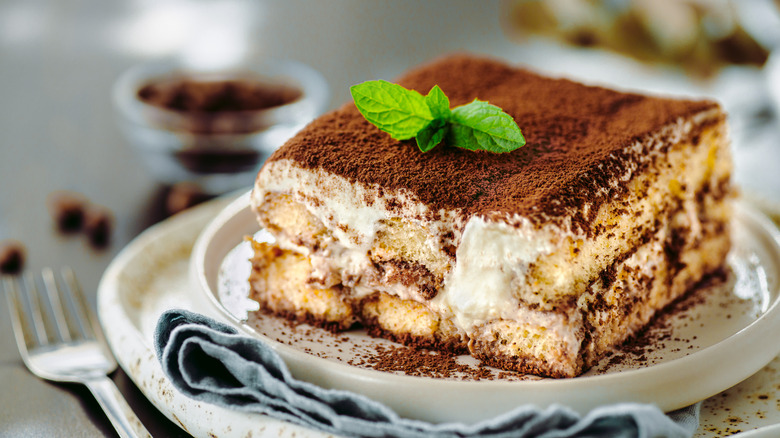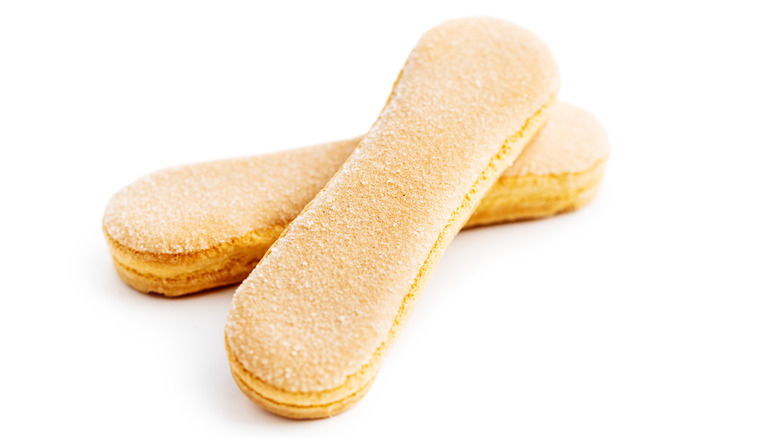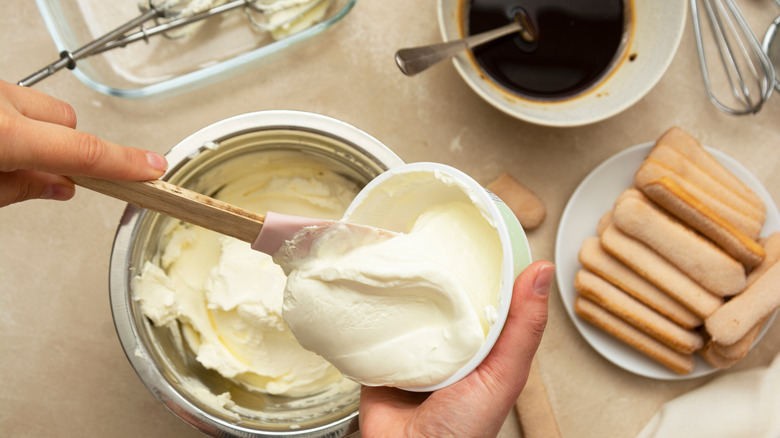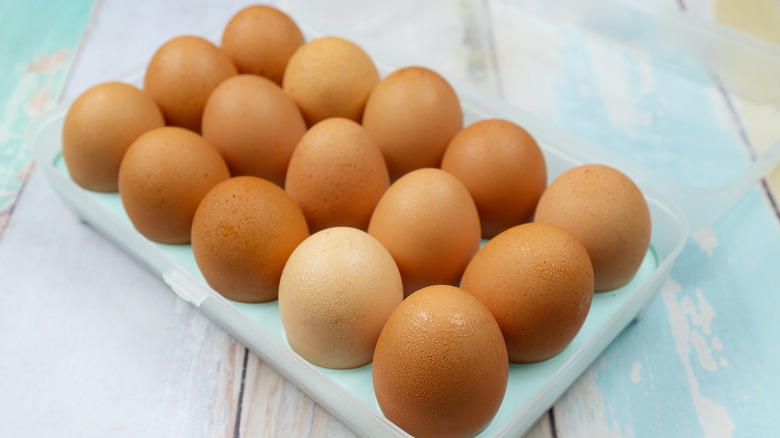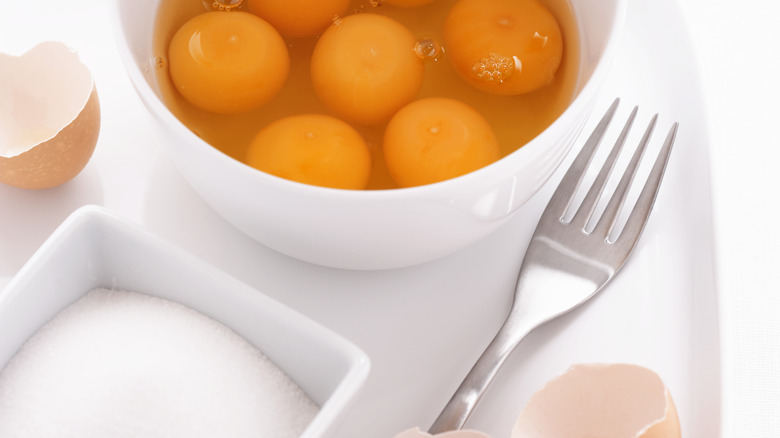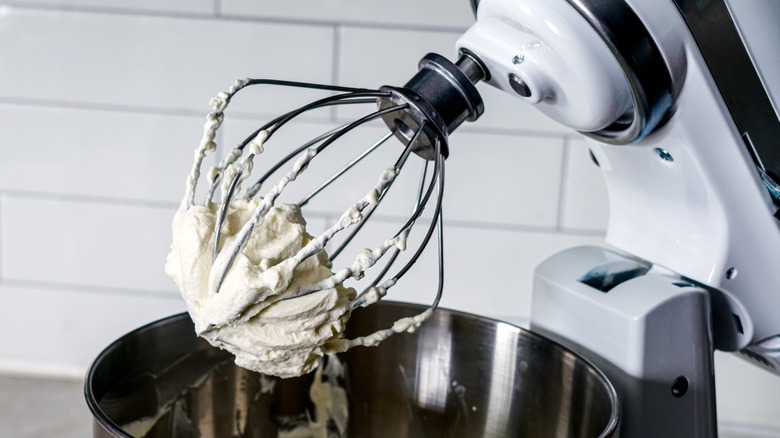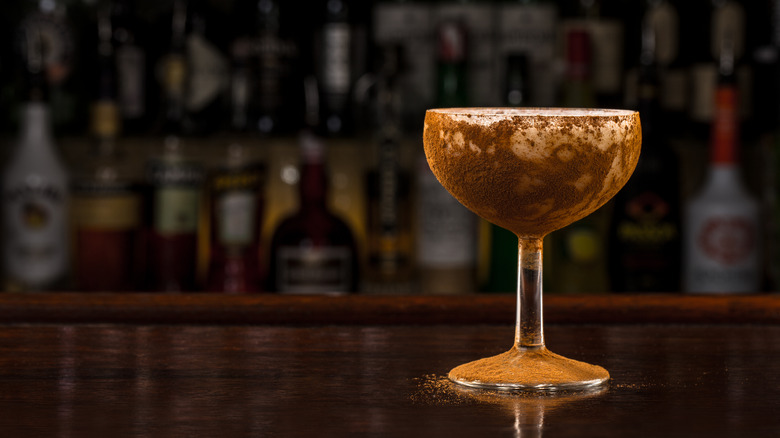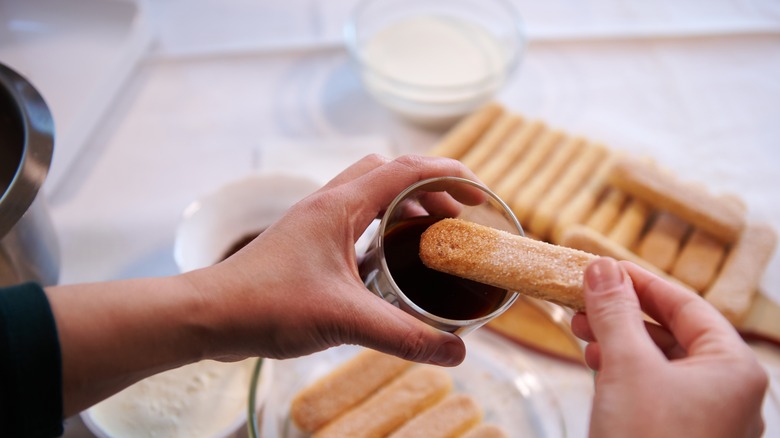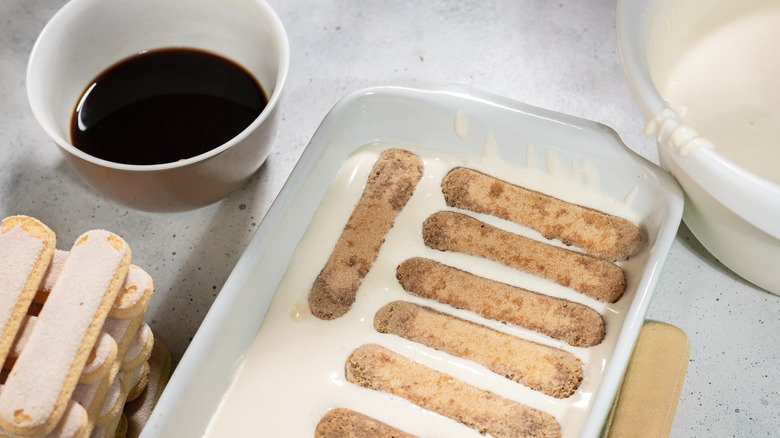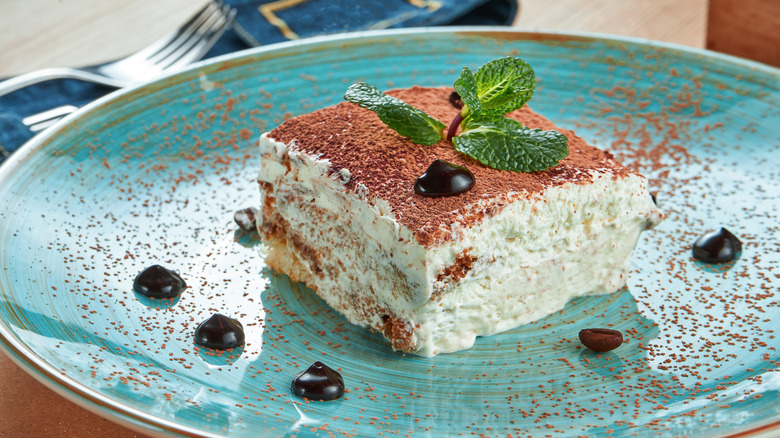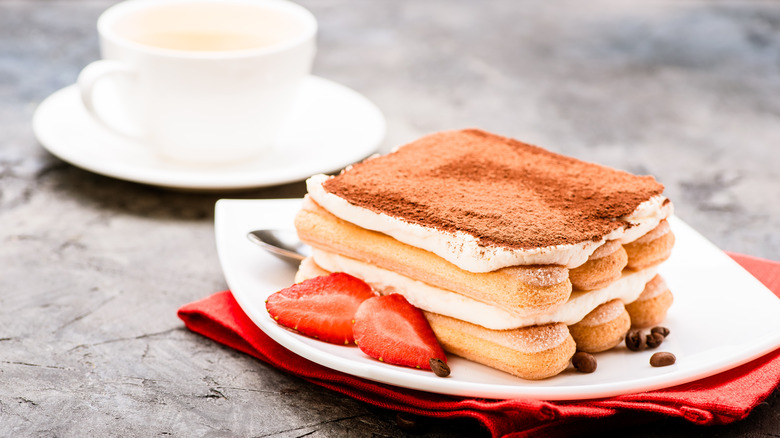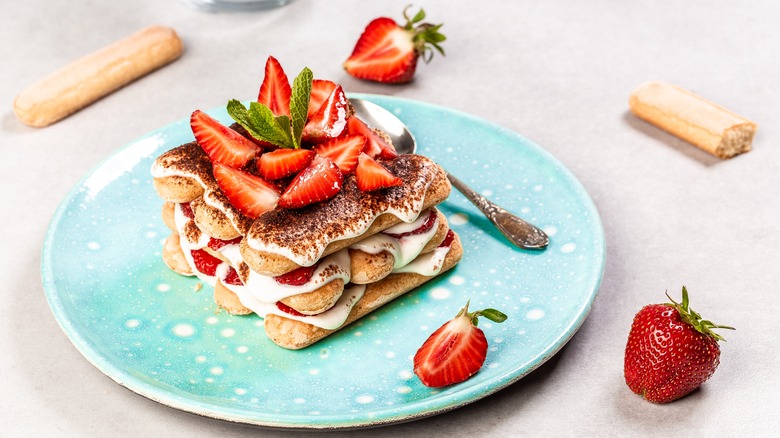12 Mistakes You're Making With Tiramisu
If you're looking to impress your guests for dessert, tiramisu should be one Italian classic in your toolbox. This layered dessert is made with ladyfinger biscuits soaked in coffee, sweet mascarpone cheese, a light-whipped cream, and a dusting of cocoa powder. According to Accademia del Tiramisu, the name of the recipe translates to "pick me up" in the Italian Treviso dialect, and the region was the birthplace of tiramisu in 1800. The exact origin of the dessert claims the mistress of a house in this region would feed the dessert as an aphrodisiac to brothel customers so that they would feel reinvigorated upon returning to their wives, according to Accademia del Tiramisu. Eventually, the site says inns in Treviso began adding the dessert to the menu and added to the dessert's subsequent popularity across the region and beyond.
Although tiramisu appears deceptively easy, there are some major ways that this dessert can reach past the point of no return. Here our some of our tips for making delicious tiramisu at home.
Using the wrong kind of biscuits
Tiramisu is traditionally made with ladyfingers biscuits. These soft cookies, known as savoiardi, are a delicate biscuit that easily soaks up the coffee flavor that gives tiramisu its flavor. Ladyfingers are the only biscuit you should use for tiramisu because of the optimal texture is perfect for absorption yet still maintains its shape while the tiramisu is setting. The other option for biscuits is pavesini: sweet biscuits that are thinner and more golden brown than the savoiardi. Although we agree that both are delicious, the savioadi are plush and more able to soak up the liquid for the dessert.
You can purchase ladyfingers from an Italian bakery or make the cookies at home. You'll need your standard cookie ingredients, as well as a piping bag to shape the 3-inch biscuits onto parchment. The cookies are done baking in under 10 minutes, and take on a deliciously light golden hue when baked to perfection. It might be hard not to eat the cookies right out of the oven.
Over-whipping the mascarpone
Mascarpone is a sweetened cheese that can make or break your tiramisu. According to Nigella Lawson, the high fat content of the mascarpone causes it to curdle easier than other types of cheeses and creams. When your mascarpone is over-whipped, the site finds it will start to resemble the texture of cottage cheese, and once the mascarpone starts to split, it is difficult to recover. But, you can take preemptive action to halt the splitting process.
Nigella Lawson recommends using cold mascarpone for whipping rather than leaving the mascarpone at room temperature before whipping. You should also only whip the mascarpone with the sweetener in a stand mixer until it just starts to come together, says Lawson, then, shut off the machine and continue mixing in the sweetener and the mascarpone by hand with a spoon. Although you might develop super strong arm muscles from mixing the heavy cheese, the mascarpone will not be as likely to split.
Forgetting to bring your eggs up to temperature
You shouldn't doubt the power of room temperature eggs. Using room temperature eggs is important in baking because of the increased volume, as well as better binding potential with other ingredients. While you might be able to get away with using cold eggs for some recipes, whipped egg preparation recipes, like angel food cake and tiramisu, necessitate the use of warmer eggs.
If you forget to pull the eggs out of the fridge before you're ready to make your tiramisu, you can use the simple hack of placing the amount of eggs you need in a bowl with warm water to take off the chill. This kitchen hack takes about five minutes to work and make a world of difference in your tiramisu recipe. If you neglect to warm-up your eggs, you should expect that the mascarpone layer won't be as smooth.
Waiting too long to mix the sugar and the eggs
Baking is all about chemistry, so it's important to mix the egg yolks and sugar immediately rather than waiting. Adding sugar to yolks changes the chemical structure of the eggs, essentially sucking the water from the surface of the egg yolk — and scalding it. The result of this chemical process is dry spots on the exterior of the egg yolk similar to a hard-boiled egg, according to Cooking EZ. And as you can probably guess, this inconsistent texture of the scalded yolk is not desirable in a seamless mascarpone cream.
Since hard lumps can develop on the yolk in less than a minute, it is important to mix the yolk and the sugar together as soon as the two come into contact. If you wait too long, Cooking EZ notes that you can use a sieve to remove the clumps before moving on to the next step in your tiramisu recipe.
Not correctly whipping your heavy cream
Incorrectly whipping heavy cream in a tiramisu recipe can have disastrous consequences. You should whip your heavy cream in a stand mixer using a whisk attachment. Turn the mixer on high to ensure that the heavy cream is completely whipped and has the same texture throughout. If you pick the challenging route and go with beating the heavy cream with a whisk, use a beating motion rather than a side-to-side motion. This will increase the amount of air going into the whipped cream and aid in the whipping process.
When adding the heavy cream to the mixture, you'll want to whip the cream until stiff peaks form. If you are looking for a way to add a personal touch to your whipped cream, consider adding vanilla bean, honey, or a sugar-free sweeter like monk fruit extract. And if you're thinking about leaving heavy cream out of your tiramisu to save on calories — don't. The heavy cream, along with the addition of whipped egg whites, help maintain the texture of the mascarpone cream.
Using instant coffee instead of something stronger
The coffee undertone in tiramisu makes the dessert a favorite for coffee lovers. While using instant coffee powder might be a quick way to infuse coffee into your ladyfingers, it should not be your go-to. Most tiramisu recipes call for strongly brewed coffee or espresso at room temperature because there needs to be enough flavor to give your biscuits a boost.
Italian dark-roasted espresso beans are best for tiramisu because the flavors impart the strongest, caramelized undertone. You can also add a splash of coffee liqueur to boost the coffee notes. Some people prefer using a lightly-roasted espresso because of its acidity, which plays against the intoxicating sweetness of the rest of the tiramisu. Drip coffee doesn't have the same robust flavor as espresso, so you might be tempted to use more of it to replicate the flavor of the espresso. Not only does this method not work, but you'll also be left with soggy biscuits.
Not trying to infuse alcohol into your tiramisu
Booze and tiramisu can be best friends. You can infuse several types of alcohol into your tiramisu depending on your preferences. The purpose of adding alcohol is both to provide flavor and moisture to the tiramisu.
You can use a dark, full-bodied porter for a beer-soaked tiramisu. The porter is simmered with robust coffee and sugar until it is slightly reduced before being cooled. The flavor notes in the porter contrast with the coffee and brightens the java undertone in the tiramisu. Other recipes include coffee liqueur, rum, marsala wine, or amaretto. Each of these alcohols produce a different flavor that can highlight other ingredients in the tiramisu. If you want to use amaretto, you can use candied orange peel as a garnish and to add a pop of color to the dish. You an also add a bit of zest to the mascarpone for more orange flavor.
Leaving the ladyfingers in the coffee for too long
There is a narrow window for dipping your ladyfingers in coffee or espresso. You want to dip your biscuits in long enough to soak up the flavors, but not long enough so that the biscuit breaks. The optimal time for flipping your cookies in the espresso is a couple seconds on each side. Coating each side is important because tiramisu is a layered dish and needs that infusion on all sides.
You'll also want to be sure your coffee and espresso is cool before dunking in your ladyfingers. This will prevent the biscuits from breaking apart further. Be sure to use fresh ladyfingers biscuits for your tiramisu — the biscuits will be at the snappiest point and will be less likely to break. If you are worried about dipping the biscuits for too long, you can add more espresso flavor from the coffee liqueur or addition of espresso powder in the mascarpone.
Messing up the assembly proportions
Tiramisu is all about layers — so you'll want to be sure that your layers are perfectly balanced for all the textures in every single bite. We should first note that if you expect every slice of your tiramisu to come out of the pan clean, you should try a different dessert. The tiramisu is meant to be a messy, yet delicious, plate of chaos.
There is no specific number of layers you should have in a tiramisu; it's mostly dependent on the pan you use. You can use a round trivet, a square baking pan, or even a pie dish to set up your tiramisu. Start by adding a layer of ladyfingers to the bottom of the pan before adding a mascarpone cream layer. If you have ample space, you can do a double or triple layer. Finish your tiramisu with a sprinkle of cocoa powder on top right before serving.
Not letting your tiramisu chill for long enough
If there is one thing you need to do to prevent a liquid tiramisu, it's adding your tiramisu to the refrigerator to cool. For the creamiest possible tiramisu recipe, you must refrigerate the tiramisu for at least a few hours before diving in. You should wait a minimum of six hours or up to two days before slicing into your dessert.
There are numerous reasons for leaving your tiramisu in the fridge for as long as possible. From a food chemistry perspective, you'll want to leave the tiramisu in the fridge to allow the flavors to meld together. The tiramisu will absorb the espresso flavor, vanilla from the biscuits, and the sweetness of the cream. From a texture perspective, the cool temperature allows the mascarpone to set and harden rather than ooze out of your carefully constructed layers. And after you put so much time into setting your dessert, why mess it up?
Not freezing your tiramisu for long-term storage
Tiramisu is a great dessert you can make ahead of time, but you might be wondering, what is the best way to keep your tiramisu fresh? Tiramisu is only good for a maximum of four days in the refrigerator. Plus, if you leave the tiramisu in the fridge in a takeout container, you risk drying out the ladyfinger biscuits.
The best way to preserve your tiramisu is to wrap the dessert in two layers of plastic wrap before completing the process with a layer of aluminum foil, according to The Food Guy. Once your tiramisu is properly sealed, the site says you can add it to the freezer for up to three months, and when it's time to defrost your tiramisu, you should avoid putting your tiramisu in the microwave because it cause the ladyfingers to fall apart and your mascarpone to split. Instead, defrost the tiramisu in your refrigerator about eight hours before you plan to eat it, says The Food Guy, which will then will keep in the fridge for an additional two or three days.
Sticking with the same recipe
A classic recipe doesn't always have to be a boring recipe. You can make tiramisu with a ton of different variations. In the fall, you can make a no-cook pumpkin tiramisu recipe with sweetened espresso, ladyfingers, and a brown sugar, pumpkin-pie spiced mascarpone layer. If you're a stickler for the more traditional flavors, you might consider making a tiramisu pie — you”ll get the same layers and flavors as a tiramisu with the addition of a crunchy crust on the bottom of the tiramisu.
If you want to deviate more from the traditional, you should try to make a tiramisu cheesecake recipe. The graham cracker crust has the infusion of instant espresso that makes this cake a coffee-lover's dream. This dessert includes the addition of cream cheese in the mascarpone, as well as Kahlua and espresso powder for a bit of a booze-infusion.
